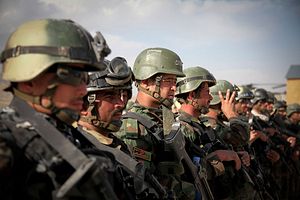A new report by the Special Inspector General for Afghanistan Reconstruction (SIGAR) — a monitoring agency that oversees reconstruction projects and other activities in Afghanistan — has found that the security situation in the country continues to worsen as the Taliban manages to seize new territory, and civilian casualties and U.S military deaths rise ever more steeply. The report comes as the Pentagon and Coalition forces attempt to implement President Donald Trump’s strategy for the 16-year-old conflict.
According to the SIGAR report, approximately 3.7 million Afghans now live in districts that are “under insurgent control or influence, an increase of 700,000 people over the last six months.” The report continues by noting that, “[a]s of August 2017, there were 54 districts under insurgent control (13) or influence (41), an increase of nine districts over the last six months.” In the Afghan context, it must be noted that “control and influence” are vague entities. The distinction lies in the fact that Kabul often controls the population centers, such as a district capital, but cedes influence over the surrounding countryside to the Taliban.
From 2001, the United States has spent approximately $714 billion on the reconstruction of the Afghanistan. In an interview with the New York Times, John F. Sopko, the special inspector general for Afghanistan, stated, “The Afghans know what’s going on; the Taliban knows what’s going on; the U.S. military knows what’s going on. The only people who don’t know what’s going on are the people paying for it.”
The successive weakness of multiple Kabul regimes have always hindered coalition efforts to rebuild Afghanistan. However, the continual ceding of territory to the Taliban is a particularly bitter pill to swallow, for if the Taliban control large tracts of land, it becomes easier to generate income, buy more weapons, and thereby hire more gunmen to continue the insurgency. These areas also become safe havens from which attacks can be launched at government officials and civilian buildings. The report warns that “[s]everal high-profile attacks this quarter further damaged public confidence in the Afghan government’s ability to safeguard the population.”
American combat casualties are also on the rise, with 10 U.S. troops killed in action from January 1 through August 23, 2017. SIGAR also counts 48 wounded. These figures represent double the number of personnel killed compared to the same periods in 2015 and 2016. With regards to the Afghan security forces, the numbers that have been killed or wounded in action have not been revealed. The apparent decision to keep these numbers private came at the behest of Afghan officials. This censorship will hinder any attempts to ascertain the progress of Afghan security forces.
More worryingly, another SIGAR report notes that of all the foreign military personnel that received training in the United States, 50 percent of those who went Absent Without Leave (AWOL) were from Afghanistan. Of the 152 trainees that went AWOL, 103 are also company grade officers, an alarming trend that will ultimately impact the operational readiness of forces back in Afghanistan. In a reflection of the often-inept Afghan Ministry of Defense and Ministry of the Interior, many interviewed trainees stated that they “did not expect to have a job upon return to Afghanistan and/or were reportedly asked to pay bribes to get their jobs back.”
Another cause for concern is a spike in the number of “insider attacks” during the past quarter. Insider attacks are when Afghans that are being trained to become a police or army officer instead attack U.S or Afghan forces. According to the SIGAR report, there have been 54 reported insider attacks from January 1 to August 15, 2017. These attacks not only seek to cause immediate damage, but also erode the trust between Coalition and Afghan troops. In a recognition of this, U.S. Defense Secretary Jim Mattis stated that insider attacks are “probably one of the most difficult aspects of this war.”
In a Congress hearing, Sopko stated that “Afghanistan is at a crossroad.” According to Sopko, Trump’s “new strategy has clarified that the Taliban and Islamic State-Khorosan will not cause the United States to leave [Afghanistan]. At the same time, his strategy requires the Afghan government to set the conditions that would allow America to stay the course.”
On the other hand, the Taliban remain defiant. In an interview with the Guardian, a militia commando speaks of the pointlessness in sending more troops to Afghanistan. The SIGAR report lays bare the challenges facing the United States and its allies in Afghanistan. The question is however, is anyone listening?
Gautham Ashok is a freelance journalist who has written for The Diplomat, Dawn, and other publications.

































